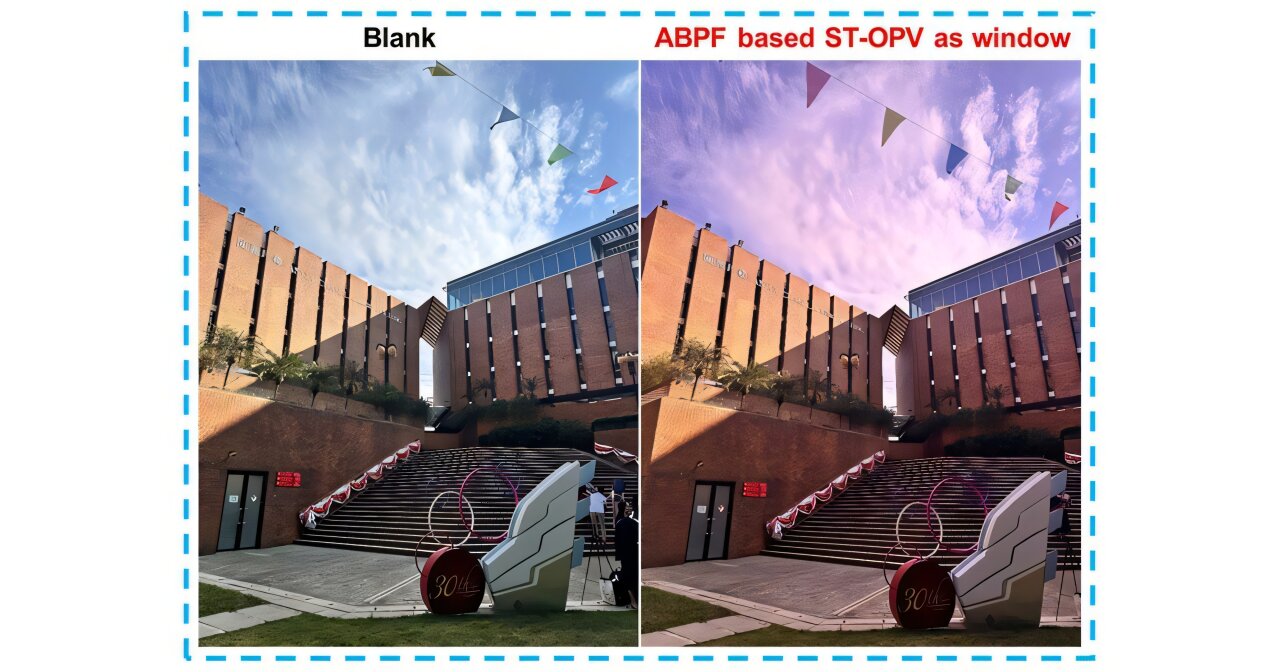A research team has developed an innovative parameter, FoMLUE, to evaluate the potential of photoactive materials for semi-transparent organic photovoltaics (ST-OPVs), paving the way for their widespread commercial applications.
A paper reporting the research, “Semitransparent organic photovoltaics with wide geographical adaptability as sustainable smart windows,” has been published in Nature Communications.
Transparent solar cells can be integrated into windows, screens and other surfaces, with immense potential for them to revolutionize the renewable energy sector. However, there are challenges to overcome, one of which is balancing transparency with power conversion efficiency.
Semi-transparent organic photovoltaics (ST-OPVs) that offer the dual advantages of efficient energy generation and visually appealing design are thus attracting significant research interest.
With their unique discrete absorption, low-cost production and environmental sustainability, ST-OPVs have very significant development potential in the field of building-integrated photovoltaics (BIPV).
To fully realize their potential in the BIPV market and beyond, scientists have combined different materials and leveraged advanced device engineering technologies to enhance the efficiency and stability of ST-OPVs, while ensuring that the color of the product appears natural under sunlight so that the photovoltaic system does not compromise the building’s visual appeal.
The researchers, led by Prof. Li Gang, Chair Professor of Energy Conversion Technology and Sir Sze-yuen Chung Endowed Professor in Renewable Energy of the PolyU Department of Electrical and Electronic Engineering, together with Research Fellow Dr. Yu Jiangsheng, introduce a dimensionless parameter, FoMLUE, to screen a series of classic photoactive materials. It takes into account the materials’ average visual transmittance, bandgap and current density by investigating their normalized absorbance.
The researchers found that ST-OPVs based on the ternary materials with the highest FoMLUE values demonstrated enhanced thermal insulation and operational stability compared with their counterparts, and achieved record light utilization efficiency of 6.05%—the highest figure of merit reported for any semi-transparent solar cell.
Their research additionally revealed the influence of geographical factors on ST-OPV performance. To explore the power generation and energy-saving performance of ST-OPV glazed windows, the research team developed a transient model to simulate power output and assess its impact on building space cooling and heating loads.
The model, applied in 371 cities across China, has shown that over 90% achieved annual load reductions. Geographical analysis has further indicated that regions with hot summers and warm winters are the most suitable for the installation of ST-OPV glazed windows, with the annual total energy saving in these regions reaching up to 1.43 GJ m⁻².
Prof. Li said, “As an emerging solar photovoltaic technology, solar windows offer new possibilities for practical deployment in BIPV, renewable energy vehicles and agricultural greenhouses.
“Our findings highlight the multifunctionality and geographical adaptability of high-performance ST-OPVs in the construction of sustainable and energy-saving smart windows without compromising the integrity of architectural design, showcasing their highly promising commercial prospects.”
Moving forward, the research team will continue to enhance the long-term stability of ST-OPVs and scale up development to large-area solar modules, both of which are essential for achieving commercialization.
More information:
Jiangsheng Yu et al, Semitransparent organic photovoltaics with wide geographical adaptability as sustainable smart windows, Nature Communications (2025). DOI: 10.1038/s41467-025-62546-8
Citation:
Semi-transparent solar cells achieve record efficiency to advance building-integrated photovoltaics (2025, October 22)
retrieved 22 October 2025
from https://techxplore.com/news/2025-10-semi-transparent-solar-cells-efficiency.html
This document is subject to copyright. Apart from any fair dealing for the purpose of private study or research, no
part may be reproduced without the written permission. The content is provided for information purposes only.


